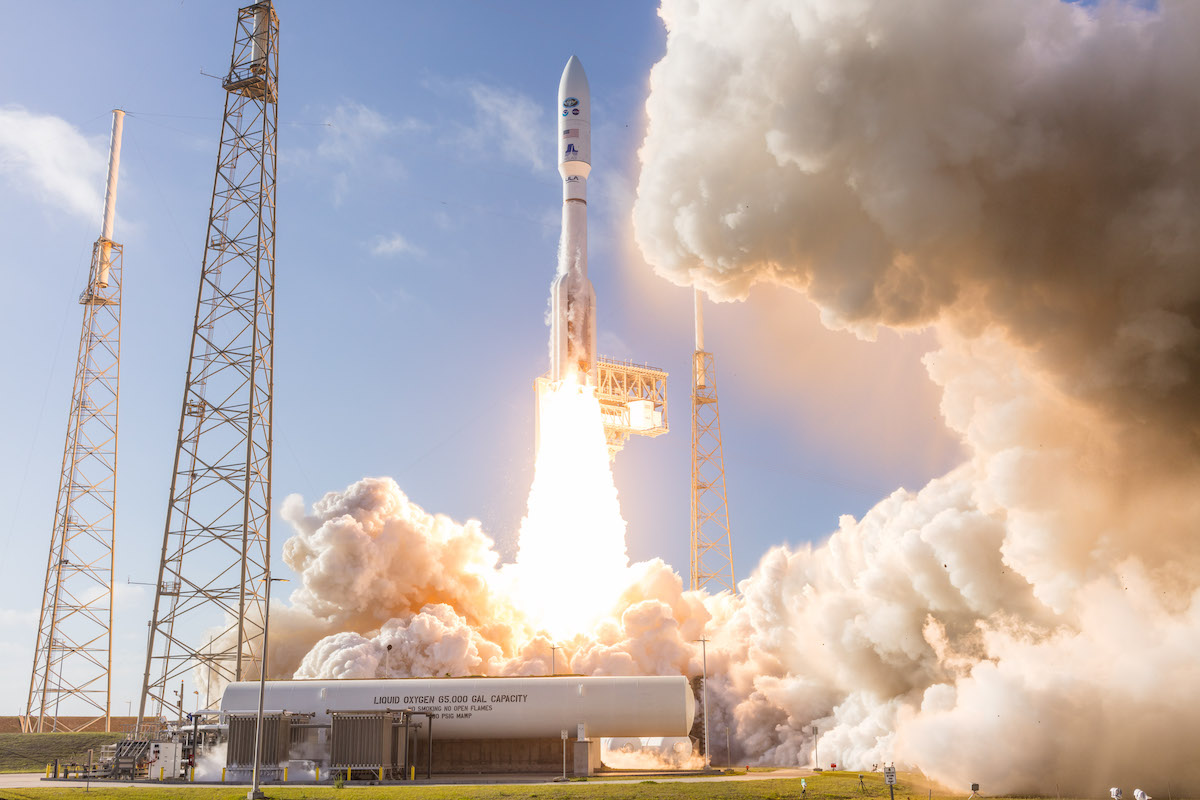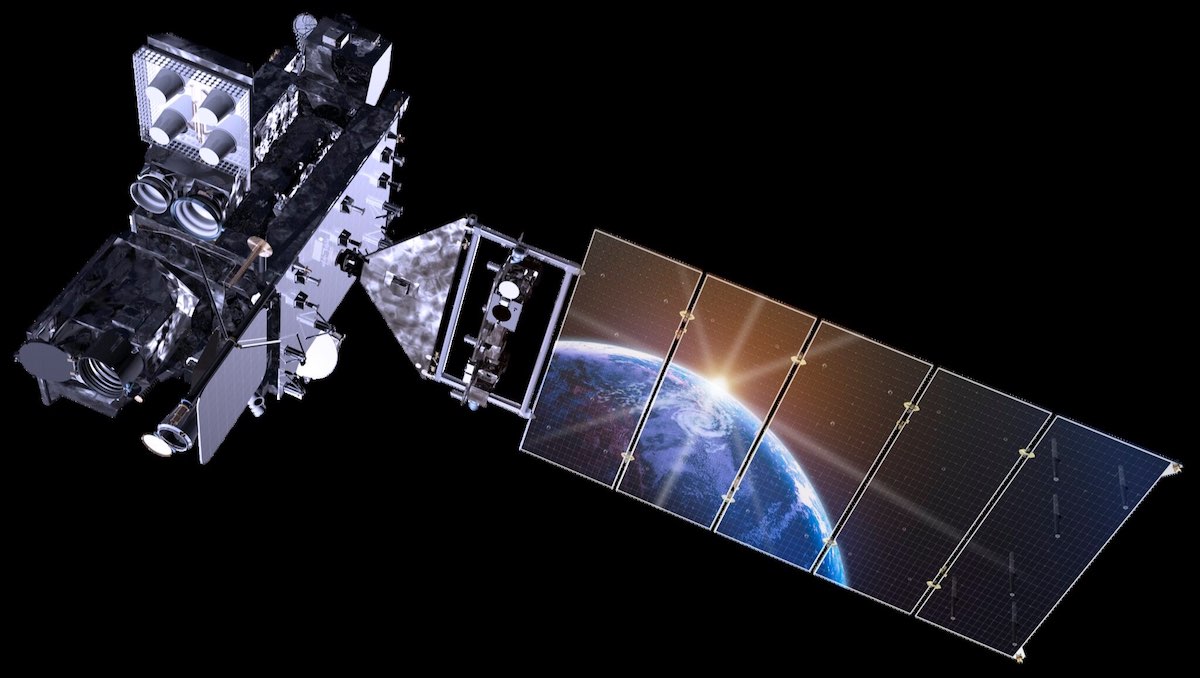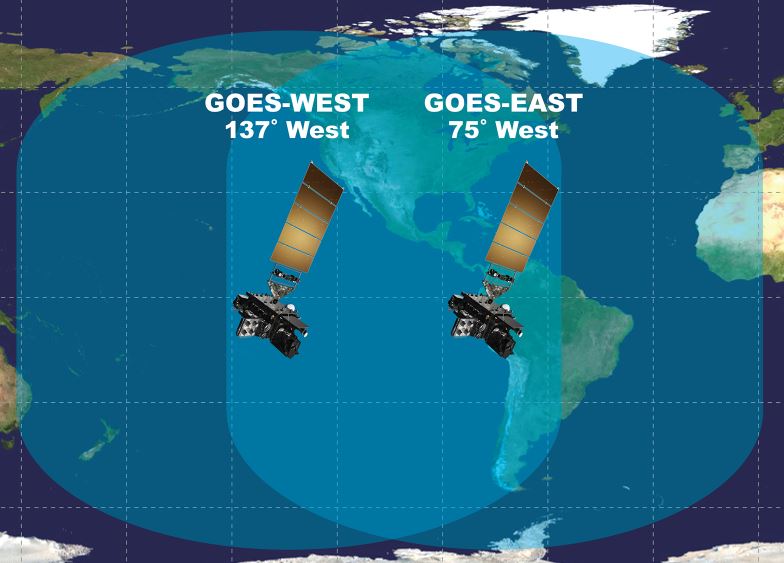
A United Launch Alliance Atlas 5 rocket lifted off from Cape Canaveral and delivered the GOES-T weather satellite into orbit Tuesday, adding a new spacecraft to NOAA’s fleet destined to become the primary observatory tracking storms over the Pacific Ocean and the Western United States.
Built by Lockheed Martin, the GOES-T satellite is the third of four spacecraft in NOAA’s latest generation of weather satellites positioned in geostationary orbit, extending a record of continuous weather observations since the first GOES satellite launched in 1975.
GOES-T lifted off aboard a 196-foot-tall (59.7-meter) Atlas 5 rocket at 4:38 p.m. EST (2138 GMT) Tuesday. Some 2.3 million pounds of thrust from the Atlas 5’s four strap-on solid rocket boosters and RD-180 main engine catapulted the launcher into late afternoon sky.
The Atlas 5 turned east from Cape Canaveral and exceeded the speed of sound in about 35 seconds. The rocket’s four boosters, made in Utah by Northrop Grumman, jettisoned about two minutes into the mission, followed by separation of the Atlas 5’s payload fairing three-and-a-half minutes after launch.
The RD-180 main engine, made in Russia by NPO Energomash, performed well during a burn lasting more than four minutes. It was the 98th flight of an RD-180 engine on an Atlas rocket, and all have been successful.
The rocket’s Centaur upper stage fired its RL10 engine, built by Aerojet Rocketdyne in West Palm Beach, Florida, three times to guide the GOES-T weather satellite into an elliptical, or oval-shaped, transfer orbit with an apogee, or high point, nearly 22,000 miles (35,000 miles) above Earth.
ULA confirmed the rocket released the GOES-T satellite right on target three-and-a-half hours after liftoff. NOAA said the satellite extended its solar array wing and started operating on its own power.
“GOES-T joins the suite of advanced technology providing critical data and imagery to forecasters and researchers tracking hazardous weather and working toward building a climate ready nation,” said NOAA Administrator Rick Spinrad.
The launch was the 92nd flight of an Atlas 5 rocket, and the 167th consecutive success for the Atlas rocket family since 1993. It was the 149th flight of Atlas and Delta rockets performed by ULA since its formation in 2006 as a 50-50 joint venture between Boeing and Lockheed Martin.
The Atlas 5 flight Tuesday came a day after Dmitry Rogozin, head of Russia’s space agency Roscosmos, that ULA’s remaining missions with the RD-180 engine will not receive technical support from the RD-180’s Russian manufacturer.
“Well, let’s pray for our American friends!” Rogozin tweeted.
Tory Bruno, ULA’s chief executive, tweeted last week that he is confident the company can fly the remaining Atlas 5 missions even without technical expertise from Russian engineers. All of the RD-180 engines needed for the 24 Atlas 5 rockets left to fly have been delivered to the United States.
“I accelerated the delivery of the last RD-180s,” Bruno tweeted, adding that ULA engineers have “lots of experience” with the RD-180 engine. “I have personal experience in flying other people’s rockets without their support, which informs my confidence,” he said.

GOES-T will use its own engine to maneuver into a circular geostationary orbit some 22,300 miles above the equator. The orbit-raising maneuvers will last around two weeks, and NOAA will remake the satellite GOES-18 once it reaches geostationary altitude.
After opening protective doors on GOES-T’s instruments, the first images from the new satellite should come down in May, and NOAA plans provide data from the new weather satellite to forecasters on a provisional basis as soon as July. It will enter operational service in early 2023.
NOAA’s fleet of Geostationary Operational Environmental Satellites, or GOES program, tracks hurricanes, severe storms, wildfires, dust storms, and other weather events in real-time, giving forecasters a minute-by-minute glimpse of evolving conditions.
The satellites are parked in geostationary orbit more than 22,000 miles (nearly 36,000 kilometers) over the equator, where they orbit Earth in lock-step with the planet’s rotation. NOAA maintains one operational GOES satellite in a western position over the Pacific Ocean and Western United States, and another GOES spacecraft in an eastern slot to cover the Eastern United States, the Caribbean, and the Atlantic Ocean.
The two operational satellites provide weather coverage from New Zealand to Africa, and from Alaska to the southern tip of South America.
The GOES spacecraft produce the sharpest real-time weather satellite views of hurricanes and storms used in television broadcasts. NOAA also operates a constellation of lower-altitude satellites in polar orbit for aid in medium- and long-term forecasting.
“NOAA’s geostationary satellites provide the only continuous coverage of weather and hazardous environmental conditions in the Western hemisphere, protecting the lives and properties of the 1 billion people who live and work there,” said Pam Sullivan, NOAA’s director of GOES-R program, which includes the GOES-T mission. “The observations from these satellites are even more critical now when the U.S. is experiencing a record number of billion dollar disasters.”
GOES-T is heading to the GOES-West location in NOAA’s fleet, where it will be parked at 137 degrees west longitude. It will replace GOES-17, formerly known as GOES-S, which launched in March 2018 and has been in the GOES-West position since 2019.
GOES-17 captured spectacular views in January of a volcanic eruption in Tonga.
The first satellite in NOAA’s latest weather satellite series — GOES-R, now GOES-16 — launched in 2016 and is operational covering the U.S. East Coast and Atlantic Ocean region, an area ripe for hurricane development.
GOES-17 suffers from degraded performance in its Advanced Baseline Imager, the satellite’s main instrument.
The ABI is made by L3Harris in Fort Wayne, Indiana, and is designed to resolve more detail in storm clouds than any previous operational weather instrument in geostationary orbit.
The camera can capture images at a faster cadence than previous GOES satellites — hemispheric views every 15 minutes, and imagery of the continental United States every five minutes. The GOES-R series of satellites can return pictures of hotspots like hurricanes at a cadence of once every 30 seconds, an improvement from the five-minute rapid scans available before 2016.
It is also able to see in 16 channels, ranging from infrared to visible wavelengths, up from five channels on the imager carried aboard the previous generation of GOES satellites.
Engineers noticed degraded vision in the imager on GOES-17 a couple of months following its launch. An investigation traced the most likely cause of the problem to foreign object debris blocking the flow of coolant in the instrument’s thermal control system. The cooling system malfunction means the instrument’s detectors are unable to stay at the proper temperatures at certain times, leading to intermittent loss of some infrared imagery.
Ground teams were able to recover some of the instrument’s lost function. NOAA now says the imager is collecting about 97% of its planned data, with most image problems confined to times when the satellite is exposed to specific thermal conditions.
“GOES-17 is still a very capable satellite,” Sullivan said in a pre-launch press conference.
NOAA operates two satellites in the GOES-West and GOES-East positions in geostationary orbit, plus spares. Credit: NOAADespite the imager problem, NOAA activated GOES-17 in the GOES-West position because it still outclassed the older satellite previously occupying that location in the fleet. But GOES-T, soon to be GOES-18, will offer even better coverage.
GOES-17 will be transitioned to a backup satellite in NOAA’s fleet.

The imagers on GOES-T and the next satellite in the series, GOES-U, have been modified to prevent a recurrence of the foreign object debris, or FOD, problem. Engineers changed the radiator design to eliminate filters where foreign object debris can become trapped.
After the problem on GOES-17, managers sent the already-finished ABI on GOES-T back to L3Harris for rework.
“Basically, the hardware that was at fault, or we determined was the most likely cause for that FOD, has been eliminated from that design,” said Larry Crawford, ABI program manager at L3Harris.
“The GOES-T satellite is very similar to its older siblings but has design changes incorporating lessons learned from GOES-R and -S on orbit,” Sullivan said.
The GOES-T satellite has an upgraded magnetometer instrument provided by NASA’s Goddard Space Flight Center, and instruments to monitor solar flares and radiation in the space environment near Earth.
Like the most recent two GOES spacecraft, GOES-T also carries a lightning mapper to detect and locate lightning strikes within the satellite’s field-of-view. The spacecraft hosts a transponder to receive and relay distress messages, part of a global space-based search and rescue repeater network.
NASA partners with NOAA on development of weather satellites, overseeing contracts to develop the spacecraft, instruments, and procure launch vehicles. NOAA operates and owns the satellites.
The GOES-R program is costing $11.7 billion, including expenditures for four satellites, instruments, launch services, and operations, according to Sullivan.
From its location with visibility over the Western United States, GOES-T will be able to detect thermal signatures and smoke plumes from wildfires, which have ravaged large areas of territory during recent fire seasons.
“GOES-West is in an ideal position out there to get a really close look at those fires,” said Dan Lindsey, NOAA’s GOES-R program scientist.
“It’s almost impossible to overstate what a significant factor GOES-T will be in the forecasting and responding to wildfires,” said James Yoe, chief administrator for the Joint Center for Satellite Data Assimilation.
The satellite’s instruments can monitor the health of vegetation before and after fires. The lightning mapper will help analysts locate where fires might occur. Lightning is a common natural cause of brush and grass fires in dry regions.
GOES-T will also be well positioned for tracking volcanic plumes over the West Coast and the Pacific Ocean, and will allow meteorologists to follow “atmospheric rivers,” huge plumes of moisture that stream across the Pacific toward North America, the source of floods, which can ultimately spawn natural disasters like landslides.
The satellite will also be useful for gathering data for numerical weather models used in global forecasting. And because most weather systems move west to east, GOES-T will see weather systems before they affect other parts of the United States east from its coverage zone.
GOES-T is designed for a service life of at least 15 years, and the four GOES-R series satellites will extend NOAA’s geostationary weather satellite coverage capability through the 2030s. GOES-U, the final satellite of the current batch, is scheduled to launch in 2024 on a SpaceX Falcon Heavy rocket.
Email the author.
Follow Stephen Clark on Twitter: @StephenClark1.
